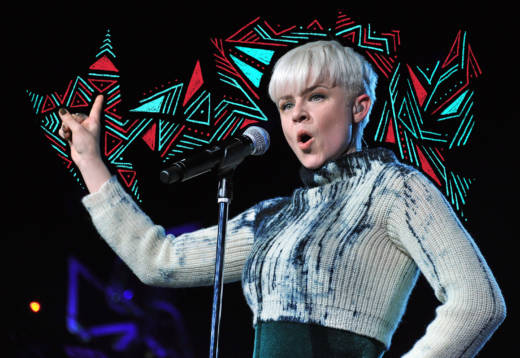There is this moment, about a minute and a half into the music video for Robyn’s flawless 2010 single “Call Your Girlfriend,” that gives us a quintessential glimpse, something just shy of a thesis, of the Swedish pop star. In it, she’s doing a highly aerobic choreographed dance in an empty warehouse, performing to the camera, which is capturing it in a single, continuous shot; the song she’s singing is premised largely on passing caring and hard-won advice about getting over a break-up to a woman through the man she is seemingly stealing from her. The song foregrounds the feelings of the two women; the romance with the new dude is somewhere in the backseat.
As Robyn is laying this drama, she’s meeting our gaze by staring intently back at us through the camera; she’s pacing through stuttering rhythmic moves, her severe silvery-white bowlcut motionless throughout. She’s fully clothed in a long-sleeve sweater, leggings and candy pink platform oxfords. She prances backwards and with a rough somersault, unfurls herself, cheek to the floor. She humps the ground in a way that recalls both Prince and a cartoon caterpillar while intoning the line “Tell her that I give you something you never even knew you missed.” The camera does not zoom in on her body; it does not grant the reassurance a close-up of Robyn’s smiling or seductive face would provide. Robyn then rolls away on the floor in her Muppet-y sweater. She’s not here to seduce us in all the hackneyed ways that are so familiar. She’s here to give us something we never even knew we missed.
Since early on in her two-decade-plus career as a pop artist, the popular line has always been that even though Robyn has the perfect voice and songs that fit seamlessly amid the bland and the bold of the American pop Top 40, she’s never quite broken through, because something is off. She’s too Euro, too cool, too weird—but that insistent “too” reveals the unspoken rules: We demand pop star girls to be less; to be vessels for our desire, not confidently expressing the complexity of their own; malleable, not showing up with an auteur’s vision. They are supposed to be writhing, glistening tits-up on the floor, not log-rolling away in a sweater. She sings on 2005’s “Who’s That Girl:”
Who’s that girl that you dream of?
Who’s that girl that you think you love?
Who’s that girl, well I’m nothing like her
I know there’s no such girl
In blunting the fantasy-girl with the real, it’s not that Robyn isn’t (fill in the blank) enough, but rather, she’s everything.

9(MDAxOTAwOTE4MDEyMTkxMDAzNjczZDljZA004))

